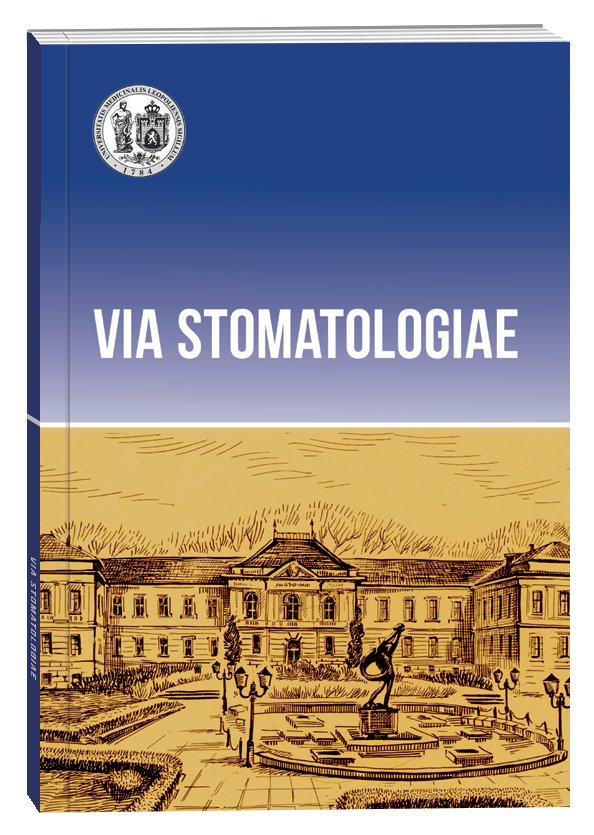МОЖЛИВОСТІ СУЧАСНОГО МРТ-ОБСТЕЖЕННЯ В КОМПЛЕКСНІЙ ДІАГНОСТИЦІ СКРОНЕВО-НИЖНЬОЩЕЛЕПНИХ РОЗЛАДІВ
DOI:
https://doi.org/10.32782/3041-1394.2024-2.7Ключові слова:
Скронево-нижньощелепний суглоб, скронево-нижньощелепні розлади, магнітно-резонансна томографія, штучний інтелектАнотація
Стандартом візуалізації м’якотканинних структур скронево-нижньощелепних суглобів (СНЩС) вважається магнітно-резонансна томографія (МРТ). З розвитком технічного та програмного забезпечення МРТ значно зросла якість візуалізації структур СНЩС, що призвело до значного покращення діагностики скронево-нижньощелепних розладів (СНР). Новітні методи, такі як ZTE, накладання МРТ-образів на КПКТ-зображення, динамічна МРТ та використання штучного інтелекту (ШІ), виводять технологію МРТ на новий рівень діагностичних можливостей. Мета дослідження – оцінити можливості сучасної МРТ у комплексній діагностиці СНР. Матеріал і методи дослідження. Проведено огляд літератури шля- хом опрацювання науково-метричних баз, у результаті чого для аналізу повного тексту було відібрано 34 статті. Результати дослідження. У стандартному протоколі МРТ-обстеження СНЩС використовують апарати із силою магнітного поля 1,5 Tл або 3 Тл та, як правило, імпульсні послідовності T1, T2, PD та Fsat при відкритому та закритому роті, описуючи структури СНЩС у косій фронтальній та косій сагітальній площинах. За допомогою динамічного МРТ (real-time MRI) можна оцінити рухи суглобової головки та диску в СНЩС, що дозволяє коректно визначити тип зміщення внутрішньосуглобового диска. Для одночасної оцінки кісткових та м’якотканинних структур використовують імпульсну послідовність ZTE або поєднання МРТ- та КПКТ-образів. Використання ШІ для діагностики СНР є доволі перспективним, проте воно вимагає залучення великої кількості даних для машинного навчання, нових критеріїв та методів аналізу. Висновки. На сьогодні покращення якості діагностики СНР за допомогою МРТ відбувається як через вдосконалення технічних характеристик апаратів, так і за рахунок розвитку програмного забезпечення, програмного об’єднання МРТ з іншими променевими методами обстеження СНЩС та використання ШІ.
Посилання
Okeson, J. P. (2019). Management of Temporomandibular Disorders and Occlusion – E-Book. Elsevier Health Sciences.
Hatcher, D. (2022). Anatomy of the mandible, temporomandibular joint, and dentition. Neuroimaging Clinics of North America, 32(4), 749–761. https://doi.org/10.1016/j.nic.2022.07.009.
Więckiewicz, M., Shiau, Y., & Boening, K. (2018). Pain of temporomandibular Disorders: From etiology to Management. Pain Research & Management, 1–2. https://doi.org/10.1155/2018/4517042.
Valesan, L. F., Da-Cas, C. D., Réus, J. C., Denardin, A. C. S., Garanhani, R. R., Bonotto, D., Januzzi, E., & De Souza, B. D. M. (2021). Prevalence of temporomandibular joint disorders: a systematic review and meta-analysis. Clinical Oral Investigations, 25 (2), 441–453. https://doi.org/10.1007/s00784-020-03710-w.
Кулінченко Р.В., Макєєв В.Ф., Кінаш Ю.О. Аналіз варіантів поєднання різних форм скронево-нижньощелепних розладів за результатами обстеження хворих. Клінічна Стоматологія. 2016. № 3. С. 35–38.
Alzahrani, A., Yadav, S., Gandhi, V., Lurie, A. G., & Tadinada, A. (2020). Incidental findings of temporomandibular joint osteoarthritis and its variability based on age and sex. Imaging Science in Dentistry, 50(3), 245. https://doi.org/10.5624/isd.2020.50.3.245.
Yadav, S., Yang, Y. T., Dutra, E. H., Robinson, J. L., & Wadhwa, S. (2018). Temporomandibular joint disorders in older adults. Journal of the American Geriatrics Society, 66(6), 1213–1217. https://doi.org/10.1111/jgs.15354.
Derwich, M., Mituś-Kenig, M., & Pawłowska, E. (2020). Interdisciplinary Approach to the Temporomandibular Joint Osteoarthritis-Review of the Literature. Medicina-lithuania, 56(5), 225. https://doi.org/10.3390/medicina56050225.
Schiffman, E.L., Ohrbach, R., Truelove, E.L., Look, J.O., Anderson, G. C., Goulet, J., List, T., Svensson, P., Gonzalez, Y., Lobbezoo, F., Michelotti, A., Brooks, S. L., Ceusters, W., Drangsholt, M., Ettlin, D. A., Gaul, C., Goldberg, L. J., Haythornthwaite, J. A., Hollender, L., Dworkin, S. F. (2014). Diagnostic Criteria for Temporomandibular Disorders (DC/TMD) for clinical and research applications: Recommendations of the International RDC/TMD Consortium Network* and Orofacial Pain Special Interest Group†. Journal of Oral and Facial Pain and Headache, 28(1), 6–27. https://doi.org/10.11607/jop.1151.
Song, H., Lee, J. Y., Huh, K., & Park, J. W. (2020). Long-term changes of temporomandibular joint osteoarthritis on computed tomography. Scientific Reports, 10(1). https://doi.org/10.1038/s41598-020-63493-8.
Lee, K. S., Kwak, H., Oh, J., Jha, N., Kim, Y. J., Kim, W., Baik, U., & Ryu, J. J. (2020). Automated detection of TMJ osteoarthritis based on artificial intelligence. Journal of Dental Research, 99(12), 1363–1367. https://doi.org/10.1177/0022034520936950.
Maranini, B., Ciancìo, G., Mandrioli, S., Galiè, M., & Govoni, M. (2022). The role of ultrasound in temporomandibular Joint Disorders: An update and future perspectives. Frontiers in Medicine, 9. https://doi.org/10.3389/fmed.2022.926573.
Yılmaz, D., & Kamburoğlu, K. (2019). Comparison of the effectiveness of high resolution ultrasound with MRI in patients with temporomandibular joint dısorders. Dentomaxillofacial Radiology, 48(5), 20180349. https://doi.org/10.1259/dmfr.20180349.
Almeida, F. T., Pachêco Pereira, C., Flores Mir, C., Le, L. H., Jaremko, J. L., & Major, P. W. (2019). Diagnostic ultrasound assessment of temporomandibular joints: a systematic review and meta-analysis. Dentomaxillofacial Radiology, 48(2), 20180144. https://doi.org/10.1259/dmfr.20180144.
Xiong, X., Zheng, Y., Tang, H., Yi, W., Nie, L., Wei, X., Liu, Y., & Song, B. (2020). MRI of Temporomandibular Joint Disorders: recent advances and future directions. Journal of Magnetic Resonance Imaging, 54(4), 1039–1052. https://doi.org/10.1002/jmri.27338.
Kamel, Z. S. a. S. A., El-Shafey, M. H. R., Hassanien, O. A., & Nagy, H. A. (2021). Can dynamic magnetic resonance imaging replace static magnetic resonance sequences in evaluation of temporomandibular joint dysfunction? Egyptian Journal of Radiology and Nuclear Medicine, 52(1). https://doi.org/10.1186/s43055-020-00396-8.
Helms, C. A., Richardson, M. L., Moon, K. L., & Ware, W. R. (1984). Nuclear Magnetic Resonance Imaging of the Temporomandibular Joint: Preliminary observations. The Journal of Craniomandibular Practice, 2(3), 219–224. https://doi.org/10.1080/07345410.1984.11677866.
Roberts, D. W., Schenck, J. F., Pm, J., Foster, T. H., Hart, H. R., Pettigrew, J. C., Kundel, H. L., Edelstein, W. A., & Haber, B. (1985). Temporomandibular joint: magnetic resonance imaging. Radiology, 154(3), 829–830. https://doi.org/10.1148/radiology.154.3.3969490.
Wang, Y., Ma, R., Li, J., Mu, C., Zhao, Y., Meng, J., & Li, G. (2022). Diagnostic efficacy of CBCT, MRI and CBCT–MRI fused images in determining anterior disc displacement and bone changes of temporomandibular joint. Dentomaxillofacial Radiology, 51(2). https://doi.org/10.1259/dmfr.20210286.
Krohn, S., Joseph, A. A., Voit, D., Michaelis, T., Merboldt, K., Buergers, R., & Frahm, J. (2019). Multi-slice real-time MRI of temporomandibular joint dynamics. Dentomaxillofacial Radiology, 48(1), 20180162. https://doi.org/10.1259/dmfr.20180162.
Lee, C., Jeon, K. J., Han, S., Kim, Y. H., Choi, Y., Lee, A., & Choi, J. H. (2020). CT-like MRI using the zero-TE technique for osseous changes of the TMJ. Dentomaxillofacial Radiology, 49(3), 20190272. https://doi.org/10.1259/dmfr.20190272.
Tălmăceanu, D., Lenghel, L. M., Bolog, N., Hedeșiu, M., Buduru, S., Rotaru, H., Băciuț, M., & Băciuț, G. (2018). Imaging modalities for temporomandibular joint disorders: an update. Medicine and Pharmacy Reports, 91(3), 280–287. https://doi.org/10.15386/cjmed-970.
Tamimi, D. F., & Hatcher, D. C. (2016). Specialty imaging: Temporomandibular joint. Specialty Imaging.
Hechler, B., Phero, J. A., Van Mater, H., & Matthews, N. S. (2018). Ultrasound versus magnetic resonance imaging of the temporomandibular joint in juvenile idiopathic arthritis: a systematic review. International Journal of Oral and Maxillofacial Surgery, 47(1), 83–89. https://doi.org/10.1016/j.ijom.2017.07.014.
Vogl, T. J., Günther, D., Weigl, P., & Scholtz, J. (2021). Diagnostic value of dynamic magnetic resonance imaging of temporomandibular joint dysfunction. European Journal of Radiology Open, 8, 100390. https://doi.org/10.1016/j.ejro.2021.100390.
Wahaj, A., Hafeez, K., & Zafar, M. S. (2016). Association of bone marrow edema with temporomandibular joint (TMJ) osteoarthritis and internal derangements. CRANIO: The Journal of Craniomandibular & Sleep Practice, 35(1), 4–9. https://doi.org/10.1080/08869634.2016.1156282.
Ravanelli, M., Bottoni, L., Buffa, I., Tononcelli, E., Borghesi, A., Maroldi, R., & Farina, D. (2021). Real-time assessment of temporomandibular joint using HASTE sequences: feasibility and comparison with standard static sequences. Dentomaxillofacial Radiology, 50(4), 20200232. https://doi.org/10.1259/dmfr.20200232.
Daiem, H. a. M. A., Abdeldayem, M. a. M., & Eldin, O. a. G. (2022). Added value of dynamic 3T-MRI to conventional static MRI in evaluation of internal derangement of tempromandibular joint. Clinical Imaging, 91, 105–110. https://doi.org/10.1016/j.clinimag.2022.07.012.
Ma, R., Li, G., Sun, Y., Meng, J., Zhao, Y., & Zeng, H. (2019). Application of fused image in detecting abnormalities of temporomandibular joint. Dentomaxillofacial Radiology, 48(3), 20180129. https://doi.org/10.1259/dmfr.20180129.
Al-Saleh, M. A., Alsufyani, N., Lai, H., Lagravère, M. O., Jaremko, J. L., & Major, P. W. (2017). Usefulness of MRI-CBCT image registration in the evaluation of temporomandibular joint internal derangement by novice examiners. Oral Surgery, Oral Medicine, Oral Pathology and Oral Radiology, 123(2), 249–256. https://doi. org/10.1016/j.oooo.2016.10.016.
Lee, J., Kim, D., Jeong, S., & Choi, S. (2018). Detection and diagnosis of dental caries using a deep learning-based convolutional neural network algorithm. Journal of Dentistry, 77, 106–111. https://doi.org/10.1016/j.jdent.2018.07.015.
Machoy, M., Szyszka-Sommerfeld, L., Végh, A., Gedrange, T., & Woźniak, K. (2020). The ways of using machine learning in dentistry. Advances in Clinical and Experimental Medicine, 29(3), 375–384. https://doi.org/10.17219/acem/115083.
Kim, J., Kim, D., Jeon, K. J., Kim, H., & Huh, J. (2021). Using deep learning to predict temporomandibular joint disc perforation based on magnetic resonance imaging. Scientific Reports, 11(1). https://doi.org/10.1038/s41598-021-86115-3.
Orhan, K., Driesen, L., Shujaat, S., Jacobs, R., & Chai, X. (2021). Development and validation of a Magnetic Resonance Imaging-Based Machine Learning model for TMJ pathologies. BioMed Research International, 2021, 1–11. https://doi.org/10.1155/2021/6656773.







